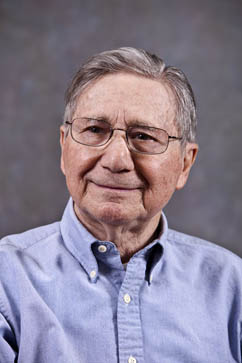
Photos and text used with permission of
Harold DeCarli.
On December 7, 1941, I turned 17 as the United States entered World War II with the bombing of Pearl Harbor; a year later I enlisted in the U.S. Navy and became an LST (Landing Ship Tank) sailor. When my tour of duty was over, I came home and enrolled in college. I graduated, married, started a family, and embarked on an interesting and challenging career in chemical engineering, which I enjoyed in a variety of industries for many years, until retiring in 1990. After I retired, my wife, Vincent, and I, who had enjoyed social ballroom dancing for 50 years, began to go out dancing twice a week. I carried on my duties as lector at our Catholic church and, with such an abundance of free time on my hands, enrolled in the Osher Lifelong Learning Institute (2,000 members and 200 volunteer instructors), where, in addition to taking courses, I teach Italian.
In July of 1993, I was experiencing urinary problems and sought the advice of a urologist (I'd been his pack leader when he and my son were in Cub Scouts as youngsters). I knew about the PSA test and asked my young friend if I should be tested. He paused and said, "Harold, if you go looking for trouble, you might find it." To which I replied, "If I am in trouble, I want to do something about it!" Well, find trouble, we did! I was diagnosed with prostate cancer, Gleason 6. Three days later I attended my first - of many - support group meetings.
As a second opinion was desperately called for, I consulted a specialist at the Hospital of the University of Pennsylvania (HUP), where my diagnosis was confirmed. After much reading and studying, I opted to undergo the recommended surgery, a radical prostatectatomy. The surgeon was performing four prostatectomies every week, so my name was added to the two-month waiting list and, in the interim, I was put on Lupron therapy. I underwent the surgery on October 14, 1993. Much to my dismay, a month later I began having difficulty urinating. I returned to HUP and learned that scar tissue had grown over the neck of the bladder. I was successfully treated and then trained in how to use a catheter. I became quite the catheter expert, as my regimen included using one every morning and every night for the next four months.
First State Prostate Support Group (under the American Cancer Society [ACS] umbrella) was established in April 1993 by an acquaintance - a fellow who had been diagnosed with metastatic prostate cancer. Before he died in 1995, he asked me to take over leadership of the group, which I did for nine years, until my 80th birthday. During this time, I was frequently asked by the ACS to give presentations on prostate cancer, sometimes with a breast cancer survivor. I developed a visual aid to explain prostate anatomy - I drilled a hole through a walnut (the prostate), drew an old plastic catheter (the urethra) through the walnut, and attached a small orange plastic bag (the bladder) next to the walnut; the connector on the catheter represented the penis.
In 2004, I began my involvement with the Department of Defense Prostate Cancer Research Program (PCRP) peer review process. Sitting side-by-side with researchers and physicians evaluating research applications has been a pleasing, rewarding, fulfilling experience. Panel members have always been very respectful, friendly, and kind, even when I said at one session, "If I had a million dollars to give to prostate cancer, I wouldn't give a nickel to this research!" (Interestingly, on that occasion, the scientist reviewers convinced me that the research had merit, and we reached a compromise in our views.)
I often wonder what all this research does for the man with prostate cancer. It may be the most novel, interesting, and excellent science, but does it tell the newly diagnosed patient if his tumor is aggressive and lethal, or slow-growing, never to cause a problem? Does it tell the many -- frequently younger -- men who have aggressive, advanced cancer, that there are better treatment options? Does it answer the critical question, "When will there be a cure?" Answers often seem to be excruciatingly elusive. However, especially in light of this, I believe we consumers must be the face of the prostate cancer patient, and their loved ones, to remind the scientists of the urgency of finding the answers.
Last updated Thursday, May 26, 2022














